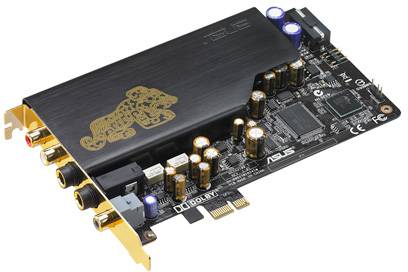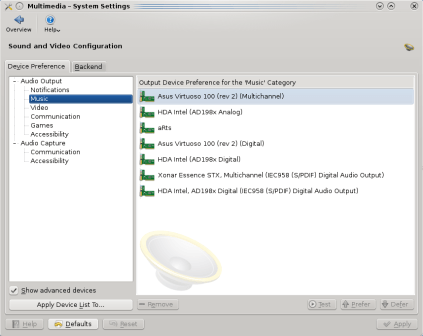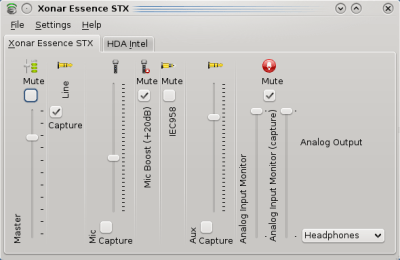Using the ASUS Xonar Essence STX Under Linux
Crave high-end audio, but use Linux? The situation surrounding this has been bad in the past, but that’s not so much the case now, especially where ASUS’ Xonar family of cards are concerned, including the headphone-specific Essence STX. Thanks to dedicated developers, the support today is just about as good as the audio quality.
When ASUS launched its first Xonar audio card in the early fall of 2007, I wasn’t sure what to think. After all, ASUS wasn’t known as an audio company, and for good reason… the Xonar D2 was the company’s first audio card. Skepticism waned from everyone’s minds soon after that launch, though, as ASUS proved that it put in the time and effort in order to deliver a quality product that rivaled the big names out there, such as Creative, Auzentech and others.
Since the initial card’s launch, we’ve seen numerous follow-up models to suit different needs and budgets. There was the DX, a sub-$100 offering that delivered pristine audio quality, like the D2, and then there’s the HDAV1.3, a card designed specifically for higher-end home theater setups. Even though ASUS proved that it was thinking outside the box, I admit I was still taken back when I saw the Essense STX at Computex 2008.
Here was a card with two 1/4″ audio jacks… a rarity in the desktop space. I pretty much stumbled over my words when I asked, “You created a card for high-end headphones and microphones?”, and after some discussion, it was revealed… it was indeed a card designed specifically for higher-end headphones, and also mics. As someone who uses headphones 95% of the time while on the PC, a card like this spoke to me. I wanted one.
Last January, I posted some information in our news section regarding using the Xonar D2X (similar to D2, just with PCI-E) under Linux. At the time, the driver was still in its infancy, but thanks to the hard work of Clemens Ladisch, it didn’t take too long before the driver was considered good-to-go and was deployed with the forthcoming (at the time) stable version of ALSA.
Since that time, the support for Xonar cards has grown, from both the features and models standpoint. The first driver supported the first-launched Xonar cards, but as it stands today, the most recent version of ALSA in the Linux kernel supports the Xonar D1, D2, D2X, DX, Essence ST (Deluxe), Essence STX and also the HDAV1.3 (Deluxe), although that one is still considered to be in the experimental stage.
I’m not going to tackle audio quality here, because for one, I’m no audiophile, and for two, we posted a robust review earlier this year, so if you want to know the nitty gritty, definitely check it out. What I can confidently say is that under Linux, no Xonar is going to sound worse than it does in Windows, although you won’t have the robust options that the ASUS Xonar Windows software offers (such as Dolby Headphone support, environment options and so forth).
The biggest thing is that if you appreciate presets or “themes”, then you might want to equip yourself with an equalizer, as that will help improve the overall impact of certain music genres. In particular, I like a little more bass with dance music, although without it, it sounds great as well. This will all depend on your personal preference. The end point is that Linux won’t limit the overall sound clarity and quality of the Xonar, so don’t worry about that.
Although the Xonar uses a popular audio chipset (C-Media CMI8788) shared by many other high-end cards, such as from Auzentech, there’s a special driver in ALSA specifically for Xonar, called “virtuoso”. Most Linux distros should detect and install this driver upon booting up, or during the install, but if you have to install it manually (beyond the scope of this small article), it’s “Asus Virtuoso 100/200 (Xonar)” you want to look for, under Device Drivers > Sound card support > ALSA > PCI sound devices. Once that driver is compiled, it can be loaded into the kernel as “snd-virtuoso”.
I recently tested out Ubuntu (9.04), to see if the Xonar was detected and installed, and sure enough, it was. Even off the live CD desktop environment, the card worked just as it should, with the options that it was supposed to offer. So, support today is a non-issue. If you are using a good distro capable of automatically detecting new hardware, then you’re probably set. If you have to take the manual route, it’s not that tough either (the best route to take is by installing the driver inside the kernel. I recommend referring to your distro’s manual to find out the best way to recompile the kernel).
Once properly installed, you should see a variety of card options in your desktop environment’s audio settings section:
Where audio controls are concerned, this is what’s available on the STX specifically:
As you can see in the screenshot above, there are few options, but what’s important is there, from the master volume for both the output and input, along with options for auxiliary capture inputs.
The drop-down menu there is available in Windows as well, and the options are “Headphones”, “FP Headphones” and “Speakers”. The first is self-explanatory, but “FP Headphones” refers to connecting your headphones to the PC via the front-panel. Speakers might sound like an odd option for a high-end headphone card, but it’s not. With these three options, you can have up three audio sources on this one card. That’s not a bad thing.
Confused about hooking up speakers to a 1/4″ jack? Don’t be, because that’s not the route you take. Rather, there are Red/White composite audio jacks on the card in addition to the others, and ASUS includes a Composite to 1/8″ Green Jack converter, which is really nice, since this minor cable can be a major pain to find in stores.
So with it installed and working, the big question has to be, “Is the card worth it?” and also, “Is it worth upgrading to the STX over another Xonar?”. The answer for both depends. The Essence STX is a $200 audio card, so it’s hard to outright recommend it to those who don’t take high-end audio somewhat seriously. If you have nothing more than a modest set of 2.1 speakers, the Xonar isn’t going to help you experience the finer sounds of your audio. The same goes for headphones. If you have a sub-$100 set of cans, you might notice a difference, but they’d still be considered a bottleneck.
If you have a pair of headphones that natively offers a 1/4″ audio jack, then it can be assumed that you have a quality set of cans that this card was built to power. Because the card allows configuration of the amp (I don’t think this is yet possible under Linux), headphones with a high impedance would be better driven with this card, although with low impedance headphones (like my Ultrasone PRO 750’s), there’s little need to touch the amp.
Since I used the Xonar D2X for the past two years under Linux using my Ultrasone’s, I knew that despite not being a real audiophile, I’d immediately notice the difference between the two cards, if there was one. Well, there are a few clear differences. Be it the amp or general design, I did notice that the bass on my headphones was far more rich, and deep on the STX. In truth, I had no idea my headphones were even capable of such bass. The first night I had the card, I threw on a few tracks, including a few hardcore dance songs (~180 BPM, tons of bass), and the result was incredible. Despite these being headphones, it almost felt like I could feel the result through my body, similar to what a good set of speakers would deliver.
Aside from that, I’m not sure if I personally notice the difference in overall audio quality, but there are other benefits to this card as well, such as swappable op-amps, and also the ability to use a high-end microphone. Both the mic and headphones have their signals separated and protected from each other under the hood, so there should be no crossover whatsoever. This card delivers as both a high-end audiophile card and a high-end card for recording. It’s a winner overall as far as I’m concerned.
I will give just one word of warning, though. I’m not sure if this goes for Windows’ users as well, but the STX can go loud, and I mean loud in the truest sense of the word. At max volume, the D2X would of course be far too loud for regular listening, but I swear that the STX is twice that. Whereas before with the D2X, 40% in my media player would be acceptable for listening, ~15% is what I use most of the time now. I made a major mistake a few weeks ago of accidentally having the volume at full blast and then putting on a song, and let me tell you… I won’t make the same mistake twice. It’s so loud, that I have little doubt that such small mistakes have the potential of damaging your hearing to a small degree permanently.
So to sum up a simple question, yes, the Xonar (the entire family) works great under Linux. If you have any questions, feel free to post them in our related thread and I’ll answer them to the best of my ability.
Discuss this article in our forums!
Have a comment you wish to make on this article? Recommendations? Criticism? Feel free to head over to our related thread and put your words to our virtual paper! There is no requirement to register in order to respond to these threads, but it sure doesn’t hurt!
Support our efforts! With ad revenue at an all-time low for written websites, we’re relying more than ever on reader support to help us continue putting so much effort into this type of content. You can support us by becoming a Patron, or by using our Amazon shopping affiliate links listed through our articles. Thanks for your support!
Rob Williams
Rob founded Techgage in 2005 to be an ‘Advocate of the consumer’, focusing on fair reviews and keeping people apprised of news in the tech world. Catering to both enthusiasts and businesses alike; from desktop gaming to professional workstations, and all the supporting software.
Thread: Asus Xonar Essence ST
Spilled the Beans
Asus Xonar Essence ST
According to the alsa website, this card (PCI version) will have driver support in ALSA 1.0.22 or kernel 2.6.33, and I believe Lucid comes with this version of ALSA.
I’m interested if this driver is a advanced as the one for the STX (PCI-E version) as it has been available since ALSA 1.0.20 or kernel 2.6.30. In particular, does the ST driver have the ability to choose headphone impedance, the ability to switch the DAC from a sharp to slow roll-off, and also alter the oversampling rate from 64x to 128x?
Any comments and experiences would be greatly appreciated.
Just Give Me the Beans!
Re: Asus Xonar Essence ST
Hey, I have the Asus Xonar Essence ST, and it worked out of the box with Alsa 1.0.22, but it didn’t have controls to change headphone impedance, changing the DAC rolloff, nor for changing the oversampling rate.
However, Alsa 1.0.23 does. Here’s a link to an upgrade script and instructions for upgrading to 1.0.23.
Then you can use alsamixer in the console to change these settings.
Be careful, though. you might have to troubleshoot when running it, and it could break your sound. Be sure and backup your system first. Note that this script will ONLY work on a non-customized kernel.
You’ll have to reinstall it every time you upgrade the kernel (in order to install the kernel module). For me, it worked the first time, but the second time (after a kernel upgrade) it broke it. I’m working on fixing it right now, and that thread (over 100 pages of replies) has LOTS of troubleshooting information.
Btw, I’m using Ubuntu Lucid (10.04) AMD-64. Good luck. the Asus Xonar Essence ST is an AWESOME soundcard.
Edit: It didn’t work after the kernel upgrade because I didn’t recompile with the script, I just tried to install it. Following the instructions from the BEGINNING made it work perfectly. Also, all three options are now in alsamixer.
Attached Images
- AlsaMixer.png (50.2 KB, 113 views)






